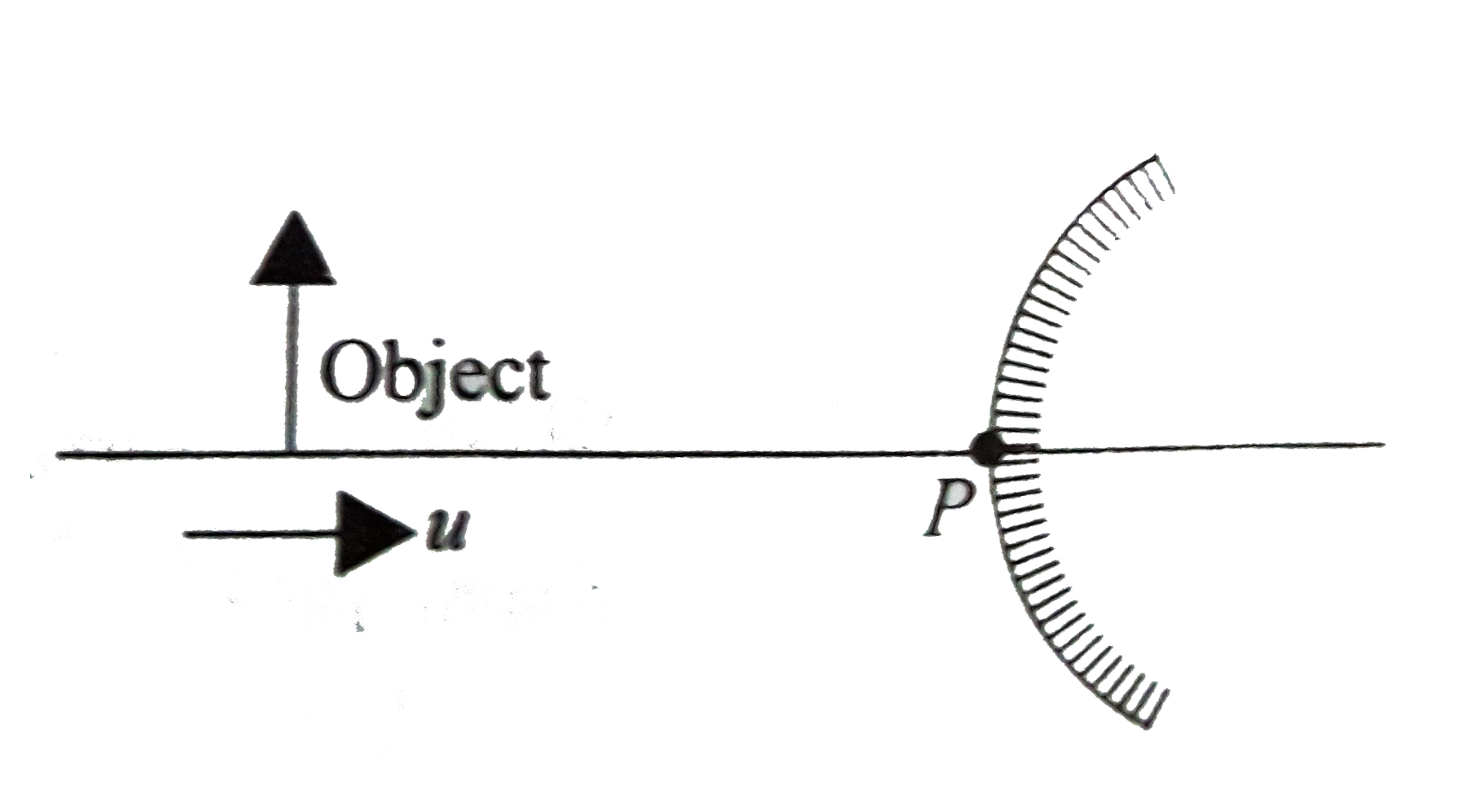A point object P moves towards a convex mirror with a constant speed V, along its optic axis,. The speed of the image
is always < V
may be >, = or < V depending on the position of P. .
increase as P comes closer to the mirror
decrease as P comes closer to the mirror
The correct Answer is:A, C, D
To solve the problem of determining the speed of the image formed by a convex mirror when a point object moves towards it with a constant speed V, we can follow these steps:
Step 1: Understand the Mirror Formula
The mirror formula for a convex mirror is given by:
1f=1v+1u
where:
- f is the focal length of the mirror (negative for convex mirrors),
- v is the image distance (positive for virtual images),
- u is the object distance (negative as the object is in front of the mirror).
Step 2: Set Up the Variables
Let:
- x be the distance of the object from the mirror (so u=−x),
- y be the distance of the image from the mirror.
Step 3: Differentiate the Mirror Formula
Differentiating the mirror formula with respect to time t:
\frac{d}{dt}\left(\frac{1}{f}\right) = \frac{d}{dt}\left(\frac{1}{v}\right} + \frac{d}{dt}\left(\frac{1}{u}\right)
Since f is constant, its derivative is zero:
0=ddt(1v)+ddt(1−x)
Step 4: Apply the Chain Rule
Using the chain rule, we have:
0=−1v2dvdt+1x2dxdt
Rearranging gives:
dvdt=v2x2⋅dxdt
Step 5: Substitute the Known Values
Since the object is moving towards the mirror with speed V, we have:
dxdt=−V
Substituting this into the equation:
dvdt=v2x2⋅(−V)
Step 6: Analyze the Magnification
The magnification m for a convex mirror is given by:
m=h′h=−yx
where h′ is the height of the image and h is the height of the object. The magnification for a convex mirror is always less than 1, which implies:
|m|<1⇒|y|<|x|
Step 7: Conclusion on Speed of the Image
From the relationship derived, since |m|<1, the speed of the image dvdt will always be less than the speed of the object V. Therefore, the speed of the image is always less than V.
Final Answer
The speed of the image is always less than V.
---
The mirror formula for a convex mirror is given by:
1f=1v+1u
where:
- f is the focal length of the mirror (negative for convex mirrors),
- v is the image distance (positive for virtual images),
- u is the object distance (negative as the object is in front of the mirror).
Let:
- x be the distance of the object from the mirror (so u=−x),
- y be the distance of the image from the mirror.
Differentiating the mirror formula with respect to time t:
\frac{d}{dt}\left(\frac{1}{f}\right) = \frac{d}{dt}\left(\frac{1}{v}\right} + \frac{d}{dt}\left(\frac{1}{u}\right)
Since f is constant, its derivative is zero:
0=ddt(1v)+ddt(1−x)
Using the chain rule, we have:
0=−1v2dvdt+1x2dxdt
Rearranging gives:
dvdt=v2x2⋅dxdt
Since the object is moving towards the mirror with speed V, we have:
dxdt=−V
Substituting this into the equation:
dvdt=v2x2⋅(−V)
The magnification m for a convex mirror is given by:
m=h′h=−yx
where h′ is the height of the image and h is the height of the object. The magnification for a convex mirror is always less than 1, which implies:
|m|<1⇒|y|<|x|
From the relationship derived, since |m|<1, the speed of the image dvdt will always be less than the speed of the object V. Therefore, the speed of the image is always less than V.
The speed of the image is always less than V.
Topper's Solved these Questions
- BOOK - FIITJEECHAPTER - OPTICSEXERCISE - COMPREHENSION- I5videos
OPTICS
- BOOK - FIITJEECHAPTER - OPTICSEXERCISE - Comprehension -II5videos
OPTICS
- BOOK - FIITJEECHAPTER - OPTICSEXERCISE - ASSERTION REASONING TYPE3videos
OPTICS
- BOOK - FIITJEECHAPTER - MODERN PHYSICSEXERCISE - Numerical based questions5videos
MODERN PHYSICS
- BOOK - FIITJEECHAPTER - PHYSICS PART-IIIEXERCISE - NUMERICAL BASED QUESTIONS DECIMAL TYPE11videos
PHYSICS PART-III
Similar Questions
A particle is moving at a constant speed V from a large distance towards a concave mirror of radius R along its principal axis. Find the speed of the image formed by the mirror as a function of the distance x of the particle from the mirror.
View SolutionWhen an object is moved away from a convex mirror, the image
View Solution
Knowledge Check
- Question 1 - Select One
As an object moves towards a convex mirror, the image
Amagnification increasesBmoves towards the mirrorCNeither (a) nor (b) happensDBoth (1) and (2) happen - Question 2 - Select One
An object is moving towards a convex mirror with a constant velocity. P is the pole of mirror.
 Amagnification of the image increases with time.Bmagnificatin of the image decreases with timeCvelocity of the image increases with timeDvelocity of the image decreases with time
Amagnification of the image increases with time.Bmagnificatin of the image decreases with timeCvelocity of the image increases with timeDvelocity of the image decreases with time - Question 3 - Select One
A particle moves perpendicular towards a plane mirror with a constant speed of 4cm/s. What is the speed of the image observed by an observed moving with 2cm/s along the same direction? Mirror is also moving with a speed of 10cm/s in the opposite direction.
(All speeds are with respect to ground frame of reference)A4cm/sB12cm/sC14cm/sD26cm/s

If an object moves towards a plane mirror with a speed v at an angle θ to the perpendicular to the plane of the mirror, find the relative velocity between the object and the image.View SolutionWhen an object moves towards a convex lens, the size of the image
View SolutionAn observer moves towards a plane mirror with a speed of 2msec. The speed of the image with respect to the observer is
View SolutionAn observer moves towards a plane mirror with a speed of 2 m/s . The speed of the image with respect to the observer is
View SolutionWhen an object moves towards a convex lens, the size of the image
View Solution

